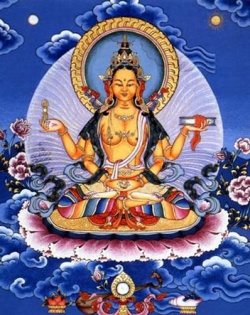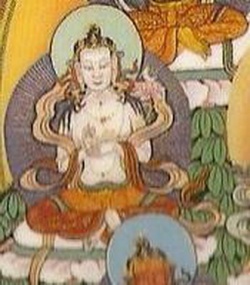Absolute truth
Absolute truth (Skt. paramārthasatya; Tib. དོན་དམ་བདེན་པ་, döndam denpa; Wyl. don dam bden pa) — one of the two truths. Absolute or ultimate reality, the way things are, as distinct from the way they actually appear.
Subdivisions
Patrul Rinpoche says:
- In essence, the absolute is the basic space of phenomena (dharmadhatu), devoid of all conceptual elaboration.
In its essence, it is without any divisions, but still it is possible to speak of ‘divisions’ according to whether or not this reality has been realized.
Thus, there are divisions into the absolute which is the basic nature itself and the absolute which is the realization (or ‘making evident’) of this basic nature.
Then again, there is the division into the absolute that is clarified through study and reflection and the absolute that is experienced through meditation practice;
or the absolute that is conceptually inferred by ordinary beings versus the absolute that is experienced directly by noble beings.
There is also a division into the conceptual absolute (namdrangpé döndam) and the absolute that is beyond conceptualization (namdrang mayinpé döndam).
As mentioned above, there is a twofold division of absolute truth:
- Uncategorized absolute (or absolute beyond conceptualization (རྣམ་གྲངས་མ་ཡིན་པའི་དོན་དམ་, namdrang mayinpé döndam)
Alternative Translations
See; "ultimate truth."
Source
The absolute Truth (Paramattha Sacca in Pali) is the "ultimate" or “deepest” Truth, which for The Buddha meant that self and no-self are both true and not true, things do and do not exist, there is no beginning or end; only a continuous cycle.
Many Spiritual traditions and even philosophical schools accept an ultimate essence of reality, an absolute Truth.
They call it by different names and they each describe it in their own unique way, but whatever it is they are referring to, it cannot be denied that there is a universal drive in the human psyche to create a representation of an absolute Truth, whether or not it is conceivable.
In Buddhism, the Three Marks of Existence (Impermanence, Suffering, and non-self) define the nature and quality of reality as taught by The Buddha.
In the absolute sense, existence is just a process of physical and Mental events in which neither self nor any permanent essence can ever be found.
We all know that there is change, but there is no “thing” that changes.
Since all things are Impermanent – they continually arise and pass away – the only thing that we can be sure of is that there is a process of change.
Thus, reality is neither being nor non-being, but only becoming.
Furthermore, this process does not have a beginning to it because if we say it had a beginning, then there would be one thing which came first, and that one thing would be the cause of everything else.
Since everything is dependent upon something else for it to arise, there cannot be something which came to be independently.
Likewise, we cannot say that there is an end to the process since everything gives rise to something else.
In general, absolute Truth is whatever is always valid, regardless of parameters or context.
The absolute in the term connotes one or more of: a quality of Truth that cannot be exceeded; complete Truth;
unvarying and permanent Truth.
It can be contrasted to relative Truth or Truth in a more ordinary sense in which a degree of relativity is implied.
Next Steps
1) In philosophy, absolute Truth generally states what is essential rather than superficial - a description of the Ideal (to use Plato's concept) rather than the merely "real" (which Platosees as a shadow of the Ideal).
Among some religious groups this term is used to describe the source of or authority for a given Faith or set of beliefs, such as the Bible.
2) In science, Doubt has been cast on the notion of absolutes by theories such as relativity and quantum mechanics .
Attempts to tie together all the known facts about the Universe into a single unified theory (one example is string theory ) could be seen as efforts to discover absolute Truth about this set of facts.
3) In pure mathematics , however, there is said to be a proof for the existence of absolute Truth.
A common tactic in mathematical proofs is the use of reductio ad absurdum , in which the statement to be proved is denied as a premise, and then that premise is shown to lead to a contradiction.
When it can be demonstrated that the negation of a statement leads to a contradiction, then the original statement is proved true.
The logical proof of the statement, "There exists an absolute Truth," is almost trivial in its simplicity.
Suppose we assert the negation of the statement, that is, that there is no such thing as absolute Truth.
By making that assertion, we claim that the sentence "There exists no absolute Truth" is absolutely true.
The statement is self-contradictory, so its negation, "There exists an absolute Truth," is true.
This proof applies only to logic.
It does not tell us whether any particular statement other than itself is true.
It does not prove the existence (or non-existence) of God, the Devil, Heaven, Hell, or little green people from another galaxy.
Neither does it assert that we can always ascertain the Truth or falsity of any arbitrary statement.
The Incompleteness Theorem , proved by Kurt Gödel and published in 1931, actually showed that there exist logical statements whose Truth value is undecidable, that is, they cannot be proved either true or false.

